
The Gallipoli campaign, the Dardanelles campaign, the Defence of Gallipoli or the Battle of Gallipoli was a military campaign in the First World War on the Gallipoli peninsula from 19 February 1915 to 9 January 1916. The Entente powers, Britain, France and the Russian Empire, sought to weaken the Ottoman Empire, one of the Central Powers, by taking control of the Ottoman straits. This would expose the Ottoman capital at Constantinople to bombardment by Entente battleships and cut it off from the Asian part of the empire. With the Ottoman Empire defeated, the Suez Canal would be safe and the Bosphorus and Dardanelles straits would be open to Entente supplies to the Black Sea and warm-water ports in Russia.

The Battle of the Nek was a minor battle that took place on 7 August 1915, during the Gallipoli campaign of World War I. "The Nek" was a narrow stretch of ridge on the Gallipoli Peninsula. The name derives from the Afrikaans word for a "mountain pass" but the terrain itself was a perfect bottleneck and easy to defend, as had been proven during an Ottoman attack in June. It connected Australian and New Zealand trenches on the ridge known as "Russell's Top" to the knoll called "Baby 700" on which the Ottoman defenders were entrenched.

The New Zealand and Australian Division was a composite army division raised for service in the First World War under the command of Major General Alexander Godley. Consisting of several mounted and standard infantry brigades from both New Zealand and Australia, it served in the Gallipoli Campaign between April and December 1915.
The Battle of Sari Bair, also known as the August Offensive, represented the final attempt made by the British in August 1915 to seize control of the Gallipoli peninsula from the Ottoman Empire during the First World War.

The landing at Anzac Cove on Sunday, 25 April 1915, also known as the landing at Gaba Tepe and, to the Turks, as the Arıburnu Battle, was part of the amphibious invasion of the Gallipoli Peninsula by the forces of the British Empire, which began the land phase of the Gallipoli campaign of the First World War.
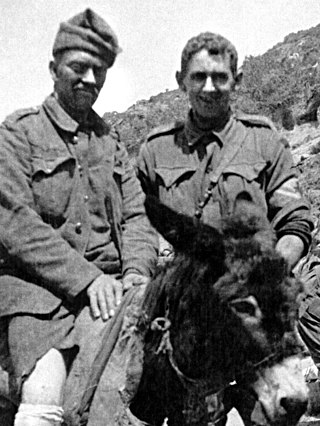
John Kirkpatrick, commonly known as John Simpson, was a stretcher bearer with the 3rd Australian Field Ambulance during the Gallipoli campaign – the Allied attempt to capture Constantinople, capital of the Ottoman Empire, during the First World War.

The Australian and New Zealand Army Corps (ANZAC) was originally a First World War army corps of the Mediterranean Expeditionary Force. It was formed in Egypt in December 1914, and operated during the Gallipoli campaign. General William Birdwood commanded the corps, which primarily consisted of troops from the First Australian Imperial Force and 1st New Zealand Expeditionary Force, although there were also British and Indian units attached at times throughout the campaign. The corps disbanded in 1916, following the Allied evacuation of the Gallipoli peninsula and the formation of I ANZAC Corps and II ANZAC Corps. The corps was re-established, briefly, in the Second World War during the Battle of Greece in 1941. The term 'ANZAC' has been used since for joint Australian–New Zealand units of different sizes.

Alfred John Shout, was a New Zealand–born soldier and an Australian recipient of the Victoria Cross (VC), the highest decoration for gallantry "in the face of the enemy" awarded to members of the British and Commonwealth armed forces. Shout was posthumously awarded the VC for his actions at Lone Pine in August 1915, during the Gallipoli campaign of the First World War. After Ottoman forces had counterattacked and seized a large stretch of the Australians' front line, Shout gathered a small party of men and charged down one trench throwing bombs. He killed eight Turkish soldiers, and managed to clear others to retake the trench. In a similar action later that day, and supported by another officer, he recaptured further ground amid heavy fighting. In the final push forward, Shout simultaneously lit three bombs to lob at the enemy. He successfully threw two, but just as the third left his hand it detonated. Shout was severely wounded and died two days later.
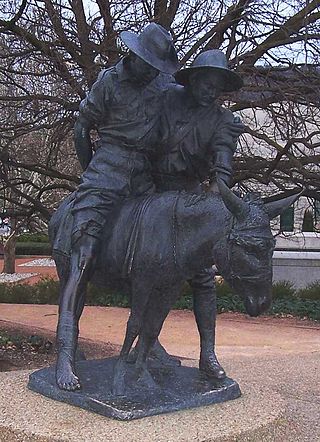
The Anzac spirit or Anzac legend is a concept which suggests that Australian and New Zealand soldiers possess shared characteristics, specifically the qualities those soldiers allegedly exemplified on the battlefields of World War I. These perceived qualities include endurance, courage, ingenuity, good humour, larrikinism, and mateship. According to this concept, the soldiers are perceived to have been innocent and fit, stoical and laconic, irreverent in the face of authority, naturally egalitarian, and disdainful of British class differences.
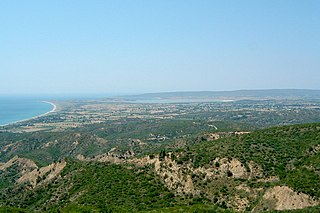
The landing at Suvla Bay was an amphibious landing made at Suvla on the Aegean coast of the Gallipoli peninsula in the Ottoman Empire as part of the August Offensive, the final British attempt to break the deadlock of the Battle of Gallipoli. The landing, which commenced on the night of 6 August 1915, was intended to support a breakout from the ANZAC sector, five miles (8 km) to the south.

George Washington Thomas Lambert was an Australian artist, known principally for portrait painting and as a war artist during the First World War.
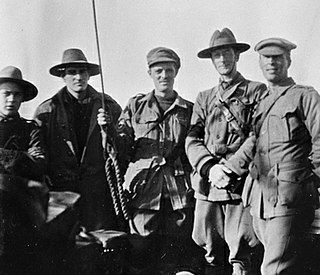
Francis Rossiter Crozier was a war records artist who is represented in the Australian War Memorial's art collection along with other Australian official war artists such as H. Septimus Power, Arthur Streeton, George Washington Lambert and Ivor Hele.

Arthur Mueller "Joe" Pearce was an Australian rules footballer who played with Melbourne in the Victorian Football League (VFL). Throughout his life, he was always known as "Joe".
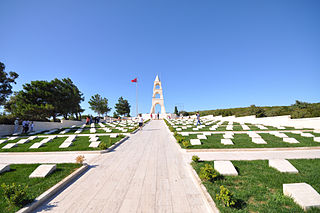
The 57th Infantry Regiment or simply 57th Regiment was a regiment of the Ottoman Army during World War I. In response to the landing at Anzac Cove of Australian and New Zealand forces on 25 April 1915 the 57th Regiment counterattacked, slowed the Allied advance and lost about half of its personnel. Mustafa Kemal later noted that the 57th Regiment was "a famous regiment this, because it was completely wiped out".
There are approximately 12,000 Australians in Turkey. Of these, the overwhelming majority are in the capital Ankara, and the remainder are mostly in Istanbul. Australian expatriates in Turkey form one of the largest overseas Australian groups in Europe and Asia. The vast majority of Australian nationals in Turkey are Turkish Australians.

Australian official war artists are those who have been expressly employed by either the Australian War Memorial (AWM) or the Army Military History Section. These artist soldiers depicted some aspect of war through art; this might be a pictorial record or it might commemorate how war shapes lives.

The 3rd Light Horse Regiment was a mounted infantry regiment of the Australian Army during the First World War. The regiment was raised in September 1914, and by December as part of the 1st Light Horse Brigade had moved overseas. The regiment only fought against the forces of the Ottoman Empire, in Egypt, at Gallipoli, on the Sinai Peninsula, and in Palestine and Jordan. After the armistice the regiment eventually returned to Australia in March 1919. For its role in the war the regiment was awarded nineteen battle honours.

The battle for Baby 700, was an engagement fought during the Gallipoli Campaign of the First World War, between the forces of the British Empire and the Ottoman Empire.

The battle for No.3 Post was fought during the Gallipoli Campaign in the First World War, between the forces of the New Zealand Mounted Rifles Brigade and the Turkish 19th Division.

Anzacs Bathing is a 1916 painting by Australian artist George Washington Lambert. The painting depicts three Anzac soldiers bathing at Anzac Cove during the Gallipoli Campaign during World War I.
Three young men frolic in the foaming blue sea, in a break from the brutalities of battle; the light gilds and defines, in scrupulous detail, the musculature of the soldiers’ bodies


















